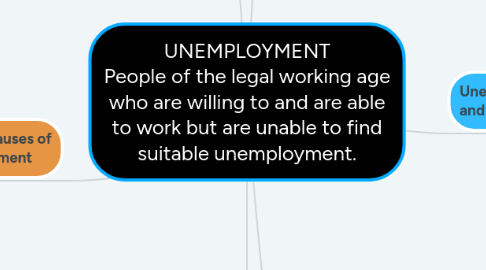
1. Nature of Unemployment
1.1. Involuntary Unemployment: Unemployment of those who are willing to work
1.2. Voluntary Unemployment: Unwilling to work, thus not part of the overall unemployment rate
1.3. Underemployment / Disguised Unemployment: Working below their productive capacity
1.4. Full Employment: Level of employment is sufficient to produce the economy's potential output
2. Types & Causes of Unemployment
2.1. STRUCTURAL UNEMPLOYMENT Unemployment that results from mismatch of skills and jobs due to change in the structure of the economy
2.1.1. CHANGE IN PATTERN OF DEMAND: Caused by change in consumer tastes and preferences. May result in unemployment of workers that have insufficient skills in other industries.
2.1.2. CHANGE IN CONDITIONS OF SUPPLY: 1. Technological Unemployment Introduction of labour-saving technology which leads to a fall in demand for labour and thus increase in unemployment. 2. Movement of the Industry to a different location, resulting in unemployment. 3. Regional Unemployment Certain regions experience full employment but other regions have unemployment (Geographical immobility of labour)
2.1.3. Is more serious than frictional unemployment as it lasts for a longer period of time and a change in skills is required
2.2. FRICTIONAL UNEMPLOYMENT When people are unemployed for a period of time while they are looking for a new job.
2.2.1. Inevitable in any free society
2.2.2. Does not pose a serious problem as long as time lag in finding employment is not too long
2.2.3. Present when people leave their job or new people (e.g. graduates) enter the work force
2.3. CYCLICAL UNEMPLOYMENT Unemployment that is associated with the business cycle - alternating booms and slumps in economic activity. Such employment is unpredictable and irregular.
2.3.1. Fall in AD which results in a fall in national income and output -> Deficiency of Effective Demand --> Fall in Demand for workers --> Increased Unemployment --> Fall in AD --> ...
2.4. SEASONAL UNEMPLOYMENT Unemployment that results in fluctuations in the level of economic activity.
2.4.1. Annual Weather Cycle
2.4.2. Traditions and Customs
2.5. REAL WAGE UNEMPLOYMENT Unemployment occurs when real wages for jobs are forced above the market clearing level.
2.5.1. Trade unions and wages councils are seen as the institutions causing this type of unemployment.
2.5.2. Excess in labour supply over labour demand.
3. Policies to Reduce Unemployment
3.1. FRICTIONAL UNEMPLOYMENT can be minimised by better job information and improvements in the employment exchange services. A labour exchange can be established, which is an institution set up by the government where people who desire to change jobs can register their requirements, and employers who desire to employ workers can register their demand.
3.2. STRUCTURAL UNEMPLOYMENT needs to be tackled by supply-side policies such as upgrading the skills of the workforce or using subsidies to manage the change in economic structure.
3.3. CYCLICAL UNEMPLOYMENT can be reduced by: 1. Using appropriate demand management policies to increase AD (monetary policy / fiscal policy) 2. Using supply management policies (used alongside AD policies) to prevent cyclical unemployment from getting worse. e.g. Providing subsidies to reduce costs of production.
3.4. SEASONAL UNEMPLOYMENT A work-sharing programme can be implemented to minimise seasonal unemployment, by spreading available employment is spread equally among workers.
3.5. REAL WAGE UNEMPLOYMENT Wages can be set at more realistic levels, reflecting the changing demand and supply conditions, instead of distorting the market by imposing minimum wage laws.
4. Measurement of Unemployment
4.1. UNEMPLOYMENT RATE: Number Unemployed ÷ Labour Force x 100%
4.2. NATURAL UNEMPLOYMENT: Frictional Unemployment + Structural Unemployment
4.3. LABOUR FORCE PARTICIPATION RATE Labour Force ÷ Working Age Population x 100%
5. Consequences of Unemployment
5.1. Economic Impact of Unemployment
5.1.1. Loss of Output of Goods and Services (and hence welfare loss) 1. Waste of scarce resources economic resources, and if prolonged, could reduce the long run growth potential of the economy. 2. Loss of output that could have been produced by the unemployed means that welfare is not maximised, 3. LRAS may fall
5.1.2. Fiscal Costs to the Government 1. Fall in tax revenue as the unemployed pay no income tax, and the unemployed spend less, thus less GST paid. 2. Increased spending on unemployment benefits.
5.1.3. Loss of Productive Capacity 1. Waste of scarce resources use in training workers 2, Erosion of skills with time --> Quality of workforce falls
5.2. Social Impact of Unemployment
5.2.1. Severe hardship and misery caused by prolonged periods of unemployment
5.2.2. Decreased real income and spending, rising scale of relative poverty and income inequality.
6. Unemployment in Developed and Less Developed Countries
6.1. DEVELOPED COUNTRIES
6.1.1. Structural Unemployment due to competition from emerging economies
6.1.2. Cyclical Unemployment due to its greater integration with the global economy and thus reliance of external demand
6.1.3. Technological Unemployment due to relatively more rapid advancements in technology.
6.2. LESS DEVELOPED COUNTRIES
6.2.1. Frictional Unemployment due to poor transport and communication systems (hence causing regional unemployment)
6.2.2. Seasonal Unemployment due to these economies predominantly being agricultural-based are affected by seasonal demand or climatic conditions.
6.2.3. Imported Cyclical Unemployment as the developed countries are their principal exports markets, and hence when the developed countries are facing cyclical unemployment, these less developed countries are affected too.

